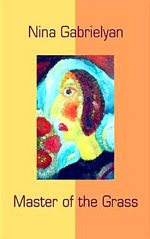

GLAS New Russian Writing, paperback, 9785717200660
MASTER OF THE GRASS: LONG AND SHORT STORIES
Translated from the Russian by Kathleen Cook, Jean MacKenzie and Sofi Cook
Reviewed by Tim Jones
Master of the Grass is a well-translated collection of one eponymous novella and six short stories by Nina Gabrielyan, a Russian writer of Armenian descent. Motifs of mirrors and dreams run through these stories, and the narratives themselves are more or less dream-like, the boundary between the sleeping and the waking world kept close and permeable, even as tragic real-world events like abortions gone badly wrong intrude.
Nina Gabrielyan is a visual artist as well as a writer, and stories concerning art and artists bookend this collection. The opening novella, "Master of the Grass", tells the story of a young poet who, like Narcissus, values his relationship with the figure who appraises him each time he looks in the mirror, above that of his relationship with the young female artist he falls in love with—a woman obsessed with insects. The figure in the mirror is a handy source of justification and exoneration as the narrator treats the fragile Polina worse and worse. I think this story would have worked better as the last rather than the first piece in this collection. "Master of the Grass" dragged a little for me, whereas the next five stories in the collection are fine examples of narrative economy, delicately balanced on the edge of the real.
My favourite of these stories was "The Lilac Dressing Gown". It includes a sentence which sums up Nina Gabrielyan's aesthetic:
This passion for transformation was perhaps the greatest of my passions.
The narrator is a young Armenian girl whose great passion is to put on her mother's lilac dressing gown and transform into a tantalising, adult figure like her mother. This story uses a technique that is very common in the literature of my own country, New Zealand: a child narrator through whom we discern the workings of the adult world, even though the narrator herself does not understand that world. For example, she observes that Yevgeny Vasilievich, a neighbour, sometimes has visitors:
Tonya was a redhead, with short hair, and always stayed over. In the night you could hear her
through the wall moaning and crying out. She apparently had terrible dreams.
It is the narrator's passion for transformation (into her mother, into the Russian girl she would like to be rather than the Armenian girl she is), and it is Nina Gabrielyan's skill in effecting such transformations, that make this story so memorable.
Another story, "Hide and Seek", starts out innocently enough, but the story darkens as it encompasses the memory of terrible events. And those same events, the massacres of Armenians by Turkish forces in 1915, also underlie the final story in the book, "The House on Metekhi Street". For me, this story wasn't as successful as those that preceded it: here, the fictional narrative about an artist and the house he lives in disappears under the weight of history. But even so, the final page summons once again the magical transformations that illuminate this collection:
A strip of blue light flickers and glints on a jug: a gateway to another space, a blue mystery
which you could never seize with your bare hands—even if you were to break the jug.
Even the stories I liked least in Master of the Grass are still worth reading, while the best stories here are worthy heirs to Gogol and to Tolstaya. If you like to see the world reflected in new ways, I recommend this collection.
